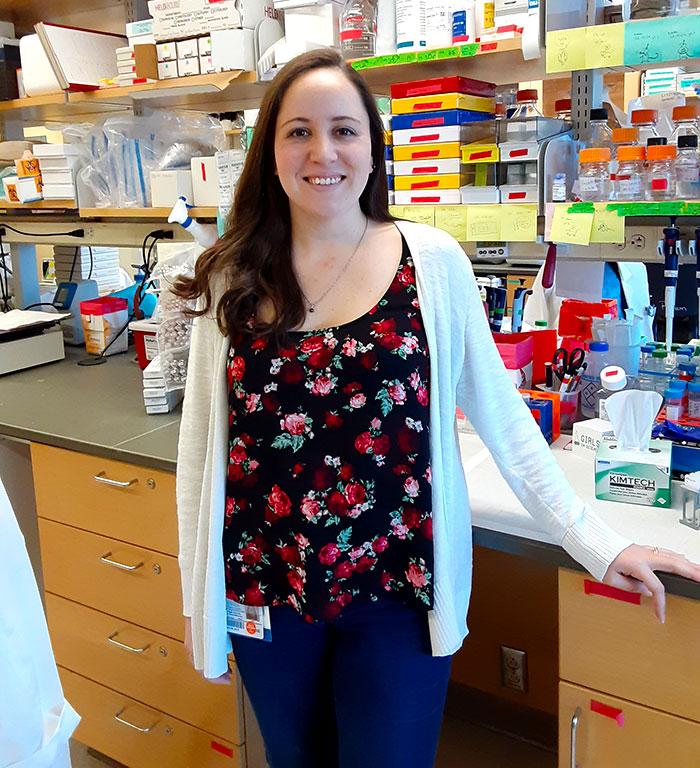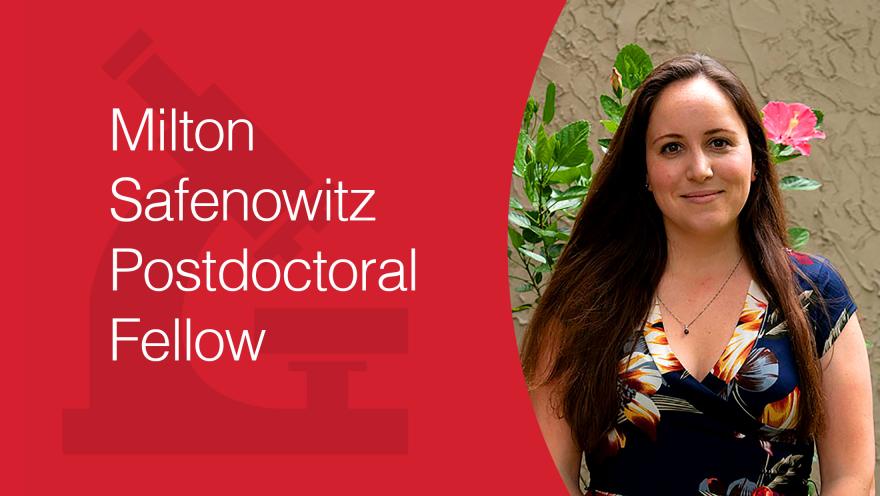ALS doesn’t stop and neither do we. The reality is, people with ALS can’t wait for treatments and a cure, and just as importantly, the tireless researchers working together around the world can’t wait to make the next breakthrough. Researchers like our 2019 Milton Safenowitz Postdoctoral Fellowship Program recipients.
Our Milton Safenowitz Postdoctoral Fellowship Program continues to support young scientists and is the only program of its kind specifically funding early ALS postdoctoral fellows eagerly searching for a cure.
The awards were founded in memory of Mr. Safenowitz by the Safenowitz family – through The ALS Association Greater New York Chapter. The program encourages young scientists to enter and, importantly, to remain in the ALS field.
We are proud that 76 percent of the postdoctoral fellows we fund go on to start their own labs to continue studying ALS and mentor other young ALS researchers. The rest of our Safenowitz fellowship program graduates go on to careers in the biomedical industry, nonprofits, and medical writing, with many still staying in the ALS space.
This year, we are supporting six new postdoctoral fellows out of a highly competitive applicant pool. Over the next few weeks, we will highlight each fellow, their dedication and unique contributions to ALS research, as well as their interests outside of the lab.
We recently talked with Dr. Lauren Laboissonniere from the Ranum lab at the University of Florida to learn about her unique research project focused on the development of novel therapeutics for the treatment of C9orf72 ALS/FTD and related repeat-associated disorders.

Lauren Laboissonniere, Ph.D.
Ranum Lab at the University of Florida
Project: Development of novel therapeutics for the treatment of C9orf72 ALS/FTD
Mentor: Laura P.W. Ranum, Ph.D.
Can you briefly describe your academic background?
I received my Bachelor of Science in Biomedical Engineering, with an emphasis on Cell and Tissue Engineering, and my PhD in Neuroscience. I have known since a young age that I wanted to study ALS, but I decided to take a non-conventional route and study engineering with the hopes of applying new insight to this field.
It is said that every 90 minutes, someone is diagnosed with ALS and every 90 minutes someone dies from the disease. Time is not on the side of those who are diagnosed, and no matter what issues we are all currently facing in the world, ALS won’t stop, so neither will we. What are you doing to address the urgency our ALS community is feeling?
This disease not only won’t stop, but its rapid progression means that time cannot be wasted. Despite the unprecedented times we are experiencing in 2020, the Ranum lab has not stopped working, even if that has meant continuing our research from home for several weeks. We are happy to be back in lab now – working in shifts to minimize contact – and have picked up experiments right where they were left off in March.
Outside of the lab, I am working with The ALS Association Florida Chapter to initiate the first Walk to Defeat ALS in Gainesville (with safe measures such as social distancing, of course). I hope this event will bring awareness to our community, as well as to provide an opportunity for patients, caregivers, researchers, and clinicians to work together to raise funds and further our development of therapies.
What are the goals of your funded research project?
My research in the Ranum lab focuses primarily on C9orf72 ALS/FTD – which is caused by a hexanucleotide expansion mutation (GGGGCC) in DNA. Patients with an abnormally high number of G4C2 repeats in their DNA may develop either ALS, frontotemporal dementia (FTD), or both diseases. One of the main molecular hallmarks of C9 ALS/FTD is the formation of toxic proteins by repeat-associated non-AUG (RAN) translation, known as RAN proteins. These proteins aggregate in neurons and targeting them has been demonstrated to alleviate phenotypes of C9 in a mouse model of the disease by members of our lab (Nguyen et al., 2020).
With this in mind, the goals of my funded research project are to develop a vaccine therapy for individuals suffering from C9 ALS/FTD, utilizing the patient’s own immune system to target the toxic RAN proteins that form. We hope that success in this pursuit will lead to further therapies for other proteinopathies and repeat-associated disorders.
Why did you decide to study ALS over other diseases?
I have lost two family members to ALS, the first being my grandfather when I was 13. After observing his brief battle with the disease and coupling that to the lack of therapies for ALS patients, I decided to pursue the development of therapies for ALS as my career. I have had the privilege of working with several brilliant scientists over the course of my career, where I have studied ALS in various manners. I spent my summers in undergrad working with Dr. Lawrence Hayward at the University of Massachusetts Medical School, then during graduate school I collaborated with Dr. Hande Özdinler of Northwestern’s Feinberg School of Medicine to investigate the transcriptomic changes occurring in early disease across several mouse models of ALS. Finally, when I began my postdoctoral position in Dr. Laura Ranum’s lab at the University of Florida, I was able to initiate my own ALS-centered research projects and have been very grateful for the opportunities that have been brought to me during this time!
What do you like about working in the ALS research field?
I think my favorite part about the ALS research field is the passion and involvement of the patients. ALS patients and their families/caregivers are some of the most inspiring, dedicated people I have encountered and working with them helps to remind us researchers just how important our work is. As scientists, it is easy to get wrapped up in your experiments and progress, but remembering the big picture helps to motivate and encourage me to work hard and produce the best data possible.
How might your work impact the ALS community?
Many of the current therapeutic options being investigated for ALS involve the delivery of a molecule, whether it be a protein, antisense oligonucleotide, or other approved drug. Our research, in collaboration with industry partners, revolves around the development and characterization of a vaccine therapy for the treatment of C9 ALS/FTD. We plan to utilize the patient’s own immune system to elicit an attack on the harmful proteins formed in C9 ALS/FTD. By targeting these proteins, we hope to allow sick neurons to return to a healthy, fully functional state. We hope that the development of a vaccine for C9orf72 ALS/FTD will facilitate early treatment of the disease, and that vaccine technology will be a successful strategy to treat other forms of ALS and proteinopathies.
Where can people get more details about your research project?
More information about my research, as well as the other exciting projects ongoing in the Ranum lab, can be found here: https://neurogenetics.med.ufl.edu/faculty/dr-laura-p-w-ranum/
It is often said that ALS is one of the most complex diseases to understand. Yet, you go to work every day to tackle the challenges of your research. What gives you hope that there will someday be a world without ALS?
I am hopeful that we will someday see a world without ALS, and that this will occur during my lifetime, because some of the brightest minds in science are researching this disease in new and exciting ways. I have met numerous ALS researchers who are devoted to their science and are approaching the field with novel ideas and techniques, so that we can best glean information about the disease and work together to formulate creative approaches toward treatment. The unyielding dedication demonstrated by many of these researchers gives me hope that now is our time.
What do you like to do when you aren’t in the lab?
Outside of the lab, I love to read, craft (cross stitching is my current obsession), and I enjoy spending time in nature – whether gardening or exploring any of the beautiful parks/springs in Florida. I am also new to photography, but I greatly enjoy taking photos of insects, birds, and other wildlife.
Is there anything else you’d like to add?
I would like to thank the ALS Association and the Safenowitz family for making this fellowship available and for investing in my research. I would also like to thank all of the patients for their continued perseverance and motivation. We get up every day thinking of you and will not stop until we find a cure!
Nguyen et al. (2020) Antibody Therapy Targeting RAN Proteins Rescues C9 ALS/FTD Phenotypes in C9orf72 Mouse Model. Neuron 105(4):645-662.e611.


Join the conversation. Please comment below.